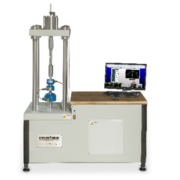Creep 101
 Creep, a crucial accuracy specification in the force measurement industry, is an important subject to include in our 101 Series. When a force is applied to a solid material within its elastic limit, the resulting deflection will subtly increase over time if the force is held constant.
Creep, a crucial accuracy specification in the force measurement industry, is an important subject to include in our 101 Series. When a force is applied to a solid material within its elastic limit, the resulting deflection will subtly increase over time if the force is held constant.
This phenomenon, known as creep, is not permanent but recoverable. The signal from a load cell exhibits this creep, making it a key consideration in all load cell applications.
Creep, or more specifically, creep error, is a term commonly used in testing. It refers to the time-dependent change in the output signal of a force sensor under a constant load. If the test will be applied under a constant load for extended periods, this change must be accounted for during the test. It’s crucial to consider this because the measurement of force will inevitably change over time.
Fortunately, creep is symmetrical and repeatable. It is more present early than later and will also taper off over time—although it does not ever stop. Therefore, when designing tests using load cells, we can calculate the effect of creep and how it will impact results.
TIP: Interface accounts for creep in our load cell accuracy specifications, by % in intervals of 20 minutes. Learn more about specifications here.
Creep happens because it deforms the strain gage, which is the sensor that measures the force. Before the gage reaches that final shape, there may be fluctuations. This would be the creep. Creep is measured in intervals because the changes in it occur over time. There is also creep, which recovery refers to the change in output that occurs over time after the load is removed from the cell, which takes away the force in turn. Usually, the operator specifies a time interval for this part. The strain gage is taking time to return to its original form and deliver a consistent output.
Additionally, all the elements in the sensor, including any mechanical elements, will respond to creep. The goal is to match the bridge’s creep behavior to the load cell material’s or flexure’s creep behavior. Creep affects both materials and sensors, but you want the result to trend in the same direction so that you get minimal error or change in the signal because of creep.
Listen and watch as Interface’s applications expert and engineer, Brian Peters, VP of Sales, details creep in our Demystifying Specifications Webinar.
Load Cell 101: Defining Creep
Creep: The change in load cell signal occurring with time, while under load, and with all environmental conditions and other variables remaining constant. Normally expressed in units of % of applied load over a specified time interval. It is common for characterization to be measured with a constant load at or near capacity.
Creep Recovery: The change in load cell signal occurring immediately after removing a load that had been applied for a specified time, with internal environmental conditions and other variables remaining constant during the loaded and unloaded intervals. Normally expressed in units of % of applicated load over a specified time interval. Normally the applied interval and the recovery interval are equal. It is common for characterization to be measured with a constant load at or near capacity.
Creep Return: The difference between load cell signal immediately after removal of a load that has been applied for a specified time interval, environmental conditions, and other variables remaining constant during the loaded interval and the signal before application of the load. Normally expressed in units of % of applied load over a specified time interval. It is common for characterization to be measured with a constant load at or near capacity.
We offer a wide variety of resources to help users understand and calculate creep so that it will not affect the performance of your test or the overall quality of the data. For instance, we touch on creep and many other considerations for optimal load cell performance in our load cell basics webinar Load Cell Basics.
We also offer a wide variety of support options if you’ve been having trouble accounting for creep or need some extra assistance understanding it. Contact our technical support team if you have any further questions about your requirements or test plan.
Load Cell Basics Sensor Specifications
Load Cell Basics Technical Q&A Part One
Load Cell Basics Technical Q&A Part Two
Interface Load Cell 101 Guide- 2024 Edition







